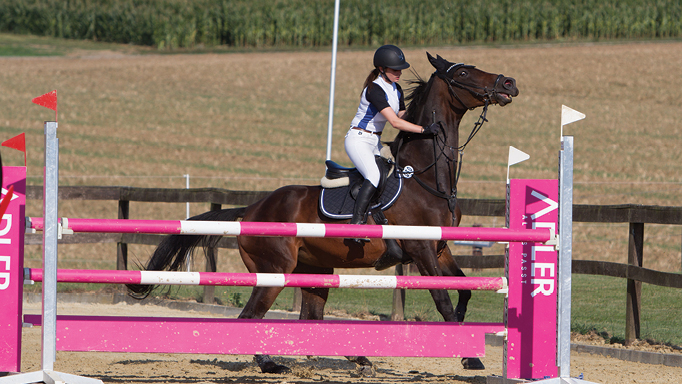Experiencing a runout or refusal during a round can be disheartening for both the horse and rider. International show jumper and top coach Beth Underhill explains how to come back after a runout or refusal more confidently, and how to reflect on that experience constructively.
It is always disconcerting when a runout or refusal happens, because it takes away confidence not just from the rider, but potentially from the horse as well. Often you see riders come back with trepidation after something has gone wrong and the rest of the ride is weaker.
What to do immediately
The first thing you should do is regroup as quickly as possible. If you were jarred loose and lost your stirrups or dropped your reins, be quick to organize, because you want to address the issue while it’s fresh in your horse’s mind. I recommend using the stick twice behind your leg, because you are reinforcing forward motion; so use a quick reaction to keep the horse thinking honestly and forward. It’s important that you pick up and establish your canter immediately.
You want to keep the horse confident by having him feel that you’re there. Not in a way that you are chasing at the jump and letting go of your reins and just being aggressive; you are going to come back positively and keeping him straight to the centre of the jump, riding decisively and with determination.
How to proceed
What’s important is that you don’t let the runout affect the rest of your round unduly, so you are going to follow your plan. You’re not going to start running down the lines and leaving out strides, or pulling and adding everywhere. You are going to try to resume where you left off and continue to be conscious of giving the horse a supported and confident ride.
If your horse runs out to the left, turn him the opposite way; make a correction that makes sense. In order to keep the horse jumping well, we need to be as accurate as we can. The higher the jump, the more accurate we need to be.
Mental dialogue
Be quick to run through in your mind what created this refusal [crooked approach, lack of impulsion, bad spot, etc.] and that’s going to give you the information you need to come up to a jump and make the correction. Try to come back with a strong, effective ride, but don’t panic. You need to keep thinking clearly and follow your plan that you had walked, and keep giving your horse the confidence to complete the round. Strength of your mind is extremely important to come back and kick yourself up a notch.
What can you work on at home?
Sometimes when things go wrong it can give us good information and I think that in order to know what to do, you need to see what created the problem. One thing that can cause refusals is a particular jump. Some horses are innately worried about liverpools, or water, or walls; so if it’s an issue with a particular fence, then you want to train that at home as much as you can.
Ultimately, the best way to prevent refusals is being prepared. That means preparing yourself for the class you are doing, having your horse strong enough, fit enough, and prepared in terms of his level of competition. The more prepared you are as a rider; the more success you will have.

